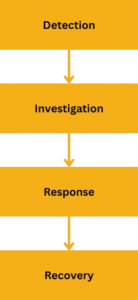- December 17, 2024
EDR Cybersecurity: Harnessing Decades of Expertise with Premier Threat Intelligence
Have you ever wondered what would happen if your business faced a sophisticated cyberattack today? Would your current defenses be enough to withstand an attack, or are you relying on outdated systems that might leave you vulnerable?
In today’s fast-paced digital landscape, traditional security measures just don’t cut it anymore. Cybercriminals are constantly evolving, and so must your defense strategy.
This is where Endpoint Detection and Response (EDR) comes in—an advanced solution that uses cutting-edge threat intelligence to identify, mitigate, and neutralize even the most complex cyber threats before they cause damage.
In this blog, we’ll explore why EDR is essential for modern cybersecurity, and how it combines years of expertise with premier threat intelligence to keep your business protected.
Ready to level up your security? Let’s dive in.
What Makes EDR Cybersecurity Essential?
Traditional antivirus software might detect viruses and block some malware, but today’s threats demand a more robust approach.
EDR services go beyond basic detection, offering a proactive, real-time defense mechanism that ensures your business remains secure even in the face of unknown attacks.
Here’s why EDR is a must-have:
- Continuous Monitoring: Tracks endpoint activity around the clock.
- Automated Threat Response: Neutralizes threats without human intervention.
- Detailed Insights: Provides forensic analysis for better understanding and prevention of future attacks.
Unlike static antivirus systems, EDR tools evolve with threats, giving businesses the upper hand.
Moreover, according to a report, nearly 90% of cyberattacks and 70% of data breaches begin at vulnerable endpoint devices, so securing these endpoints with EDR becomes critical.
Now that you understand why it is essential for modern cybersecurity, it’s time to explore the driving force behind its success—the advanced intelligence that transforms reactive defenses into proactive strategies.
Unleashing the Power of Threat Intelligence
Threat intelligence is the foundation of any effective EDR solution. By gathering and analyzing data from millions of endpoints worldwide, managed EDR solution armed with premier threat intelligence create an unbeatable defense shield.
How Threat Intelligence Works
- Global Monitoring: Tracks threats in real-time from every corner of the world.
- Dark Web Insights: Monitors malicious activity where attacks are planned.
- Predictive Analytics: Identifies potential attack patterns before they occur.
Did You Know? Businesses leveraging advanced threat intelligence are 3x more likely to prevent breaches compared to those using traditional cybersecurity tools.
How EDR Works: A Step-by-Step Breakdown
With a solid grasp of how threat intelligence empowers EDR, let’s break down the mechanics of how this technology works to defend your business every step of the way.

Step 1: Detection
EDR solutions are equipped with advanced algorithms that continuously monitor endpoints for anomalies. Unlike traditional antivirus software, EDR doesn’t rely solely on known threat signatures.
Instead, it analyzes behaviors—such as unusual login attempts, unauthorized file modifications, or unexpected network activity—to detect potential threats in real time. This ensures even zero-day attacks don’t slip through the cracks.
Step 2: Investigation
Once a potential threat is detected, the managed EDR solution shifts into investigation mode. It collects and analyzes detailed data, including timelines, affected files, and user actions, to determine the nature and scope of the threat.
This forensic analysis provides insights into how the attack occurred, what systems were affected, and whether any data was compromised.
Key Advantage: This step enables businesses to pinpoint the incident’s root cause and implement steps to prevent future attacks.
Step 3: Response
After identifying the threat, the EDR system takes immediate action to contain and neutralize it. This may include isolating the affected endpoint from the network, terminating malicious processes, or blocking further attempts by the attacker.
The automated response ensures minimal time is lost, reducing the chances of the threat spreading or causing significant damage.
Step 4: Recovery
Once the threat is neutralized, the focus turns to restoring normalcy. The EDR system helps recover compromised files, restore system functionality, and reintegrate the isolated endpoint into the network.
Additionally, it provides actionable recommendations to strengthen defenses and reduce vulnerabilities exposed during the incident.
The Result: A swift, seamless process that minimizes downtime and ensures your business stays resilient in the face of attacks.
By incorporating these steps into a cohesive strategy, EDR as a service doesn’t just defend—it continuously adapts and evolves to keep your business protected.
Conclusion
The battle against cyber threats is relentless, but with the right tools and expertise, you can stay ahead. EDR services don’t just protect—they empower your business to thrive in a digital-first world by transforming how you detect, respond to, and recover from threats.
At Asgard Managed Services, we don’t just offer solutions; we provide a partnership built on trust, innovation, and a relentless drive to safeguard your business.
With our advanced EDR capabilities and decades of expertise, we help you turn every endpoint into a fortress.
Ready to redefine your cybersecurity strategy? Let us be your trusted ally in the fight against modern cyber threats. Together, we’ll keep your business secure and a step ahead.
Also Read: How Can Managed EDR Services Improve Incident Response Times




